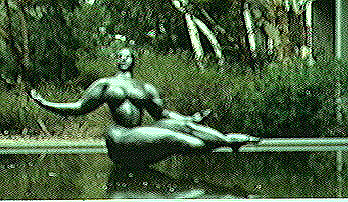

Map Ref. 7. The grey slate pool in the Winter Garden. Photographed with a digital camera for this project.
Gaston Lachaise's reclining female nude figure appears floating on the water, although she is actually supported beneath by two thin poles. The head and torso are erect, with the arms held outstretched, hands open, as in the encompassing prayer position, known as the 'Orrans' position. Below the waist, the legs are crossed and placed to one side, like a mermaid's tail. This pose, whilst looking awkward and unnatural, nevertheless manages to convey a sense of joy and feminine fecundity.
The model was Lachaise's muse and subsequently his wife, Isabel, a woman whose physical attributes always fascinated the sculptor. Lachaise was always particularly interested by the way his wife's physique deviated from the popular ideal of female proportions. At the time, contemporary art academies advocated the classical and neo-classical proportions of Greek sculpture of the archaic and classical periods.
Whilst Isabel Lachaise was only 5'2" tall, she had large breasts and buttocks but a small waist, ankles and feet. When speaking about a later reclining nude called La montagne héroéque [The large mountain], 1934, which exists in several versions, Lachaise said,
"Whatever I have of tranquillity I get from my wife. What I am aiming to express is the glorification of the human being, of the human body, of the human spirit with all there is of daring and magnificence."
After Lachaise's death from leukemia, his widow, Isabel, established the Lachaise Foundation in Boston. This Foundation furthers the work of her late husband, by issuing limited edition casts made from the existing plaster originals. These casts are only sold to art institutions, such as the National Gallery of Australia.